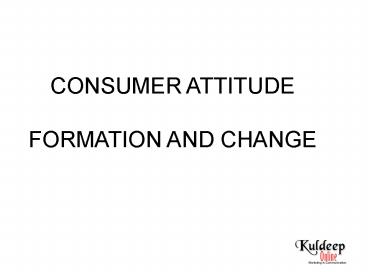CONSUMER ATTITUDE - PowerPoint PPT Presentation
1 / 13
Title:
CONSUMER ATTITUDE
Description:
YOU GET THE BEST DEAL IN EBONY'S MONSOON SALE. ... Conation. Cognition. Affect. Schematic Conception of Attitudes. Affect. Cognition. Behaviour ... – PowerPoint PPT presentation
Number of Views:251
Avg rating:3.0/5.0
Title: CONSUMER ATTITUDE
1
CONSUMER ATTITUDE FORMATION AND CHANGE
2
WINDOWS XP IS SUPERB MCDONALDS SEC 18 PROVIDES
BETTER SERVICE THAN SEC16 KHADIMS SHOES ARE
VERY COMFORTABLE YOU GET THE BEST DEAL IN
EBONYS MONSOON SALE. GLISTER IS THE ONLY
TOOTHPASTE TO PROTECT YOU AGAINST CAVITIES. I
LIKE A R RAHMAN BUT HIS CURRENT ALBUM IS NOT
THAT GOOD. I LOVE EATING OUT BUT NOT AT LATE
NIGHT OR ALONE. THE NEW PEPSI CAN IS JUST TOO
MUCH.
3
WHAT ARE ATTITUDES?
- A whole universe of consumer behaviors --
- consistency of purchases, recommendations
- to others, top rankings, beliefs, evaluations,
- and intentions are related to attitudes.
- What, then, are attitudes. In a consumer
- behavior context, an attitude is a learned
- predisposition to behave in a consistently
- favorable or unfavourable way with respect
- to a given object.
4
THE ATTITUDE OBJECT IT COULD BE ANYTHING LIKE
PRODUCT, PRODUCT CATEGORY, BRAND , SERVICE,
POSSESSIONS, PRODUCT USE, CAUSES OR ISSUES,
PEOPLE, ADVERTISEMENTS, INTERNET SITE, PRICE,
MEDIUM, PACKAGING , OR RETAILER. ATTITUDES ARE A
LEARNED DISPOSITION. ATTITUDES HAVE CONSISTENCY
AND DESPITE THEIR CONSISTENCY , THEY ARE NOT
NECESSARILY PERMANENT THEY DO CHANGE. ATTITUDES
OCCUR WITHIN A SITUATION ONE COULD BUY
DIFFERENT SHAVING CREAM EVERY TIME. ONE MAY HIRE
CAR FROM THE SAME COMPANY EACH TIME. ONE IS READY
TO TAKE LUNCH BUT NOT DINNER AT MCDONALDS.
5
tricomponent attitude model
According to the tricomponent attitude model,
attitudes consist of three major components a
cognitive component, an affective component, and
a conative component .
Conation
Affect
Cognition
6
Schematic Conception of Attitudes
Independent variables
Intervening variables
Affect Cognition Behaviour Or conative
Stimuli (Individuals, situations, social issues,
social group, and other objects
Attitude
Statements and actions Statements
Statements of feelings, love, affection
actions of actions concerning and
preference knowledge and
behaviour beliefs intentions to buy
scale
7
Multi-attributes of Choice Models
Choice Models
Theory of trying to Consume Even when the outcome
is not Known.
Theory of reasoned actions By including
subjective norms Or social approvals.
Attitude towards the ad Feelings form the beliefs
and Cognitions form the attitude Leading to
attitude towards Brand.
The Attitude Toward Objects (ATO) Models An
adequate level of favorable attributes Are
required to select or reject.
Attitude towards behavior Model Purchasing a BMW
is more about Purchasing than having positive
attitude Towards German cars.
8
how attitudes are learned
- Classical Conditioning
- Instrumental Conditioning
- Cognitive Learning Theory
- SOURCES OF INFLUENCE ON ATTITUDE FORMATION
- Direct and Past Experience
- Influence of Family and Friends
- Direct Marketing
- Exposure to Mass Media
- Personality Factors
9
Functions of Attitude
Strategies of attitude change
The utilitarian function
The Knowledge function
The value
The ego defensive expressive
function Function (outlook, lifestyle)
10
STRATEGIES OF ATTITUDE CHANGE
- Changing the Basic Motivational Function
- THE UTILITARIAN FUNCTION
- THE EGO-DEFENSIVE FUNCTION
- THE VALUE-EXPRESSIVE FUNCTION
- THE KNOWLEDGE FUNCTION
- COMBINING SEVERAL FUNCTIONS
- Associating the Product with a Special Group,
Event, or Cause - Relating Two Conflicting Attitudes
- Altering Components of the Multi-Attribute Model
- CHANGING THE RELATIVE EVALUATION OF ATTRIBUTES
- CHANGING BRAND BELIEFS
- ADDING AN ATTRIBUTE
- CHANGING THE OVERALL BRAND RATING
- Changing Beliefs About Competitors Brands
- The Elaboration Likelihood Model (ELM)
11
The elaboration likelihood model (ELM) suggest
that a persons level of involvement during
message processing is a critical factor in
determining which route to persuasion is likely
to be effective.For example, as the message
becomes more personally relevant (as involvement
increases),people are increasingly willing to
expand the cognitive effort required to process
the message arguments.Thus, when involvement is
high, consumers follow the central route and base
their attitudes/choices on the message
arguments.When involvement is low,they follow the
peripheral route and rely more heavily on other
message elements(e.g., background music)to form
attitudes or make product choices.
12
BEHAVIOR CAN PRECEDE OR FOLLOW ATTITUDE FORMATION
- Cognitive Dissonance Theory Advantage and
disadvantage of selections made - Attribution Theory ( Blame or credit)
- Self-Perception Theory
- INTERNAL AND EXTERNAL ATTRIBUTIONS AND DEFENSIVE
ATTRIBUTIONS - FOOT-IN-THE-DOOR TECHNIQUE SITUATIONS IN WHICH
CONSUMERS - COMPLIANCE WITH AMINOR REQUEST AFFECTS SUBSEQUENT
- COMPLIANCE WITH A MORE SUBSTANTIAL REQUEST. IT IS
A STUDY OF - BENEFITS OFFERED IN SALES PROMOTIONS.
13
- Attributions Toward Others
- Attributions Toward Things
- How We Test Our Attributions
- 1. Distinctiveness
- 2. Consistency Over time
- 3. Consistency Over modality
- 4. Consensus.































